You can make my delicious Miso Ramen with authentic broth at home in less than 30 minutes! Add optional ramen eggs and chashu (Japanese braised pork belly) or customize it with your favorite toppings. It‘s a piping-hot bowl of soulful goodness that‘s sure to satisfy your ramen cravings.
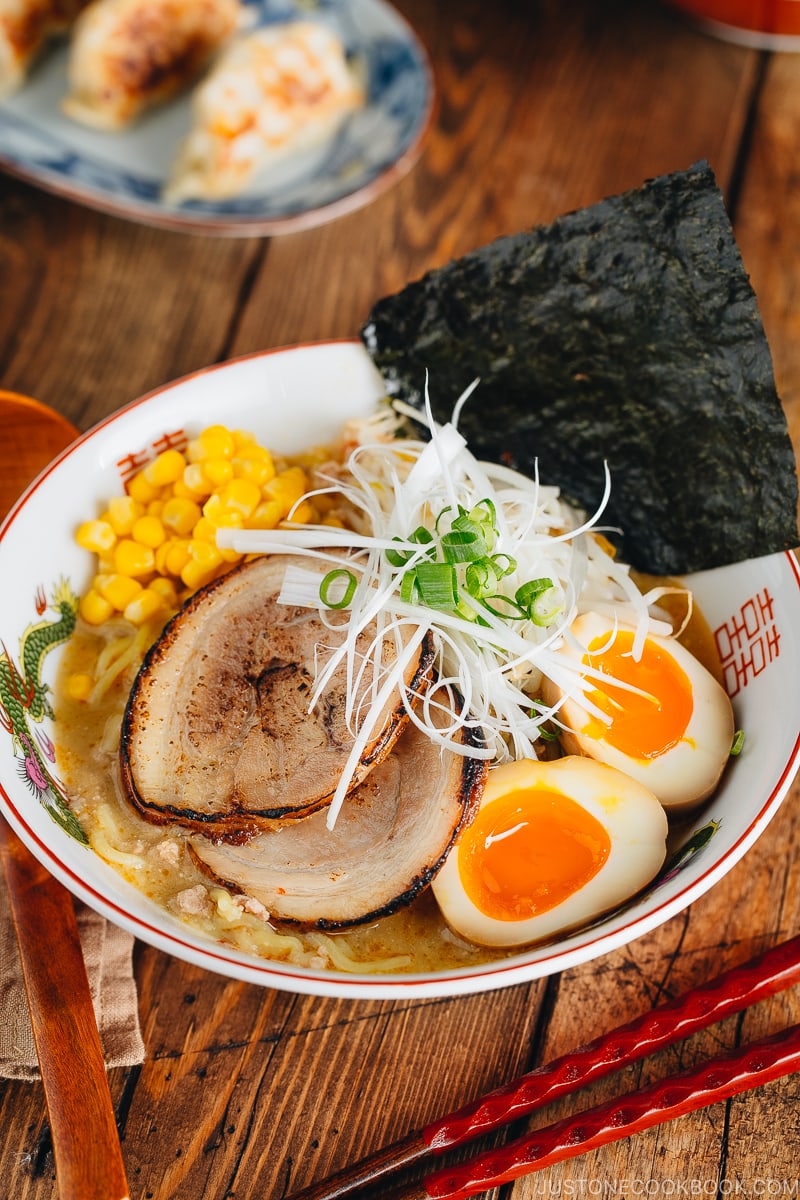
When you’re in Japan, you will quickly learn that there are 3 basic ramen flavors: shio (salt), shoyu (soy sauce), and miso (fermented soybean paste).
If you’re wondering about the tonkotsu ramen, that’s actually a type of broth base and the tonkotsu means a pork bone broth. If you’re interested in learning more about ramen, read our Japanese Ramen Guide for Beginners.
Today we’ll make the popular and my favorite, Miso Ramen (味噌ラーメン).
Learn How to Make Miso Ramen at Home
Ramen consists of 3 components: soup, noodles, and toppings. In this post, I’ll go over each topic in detail.
Part 1: Ramen Soup スープ
Although the Japanese enjoy eating ramen at ramen shops, it is common for Japanese moms to make ramen at home. Making good ramen soup from scratch requires a lot of time and effort, so most households use packaged ramen which includes 2-3 servings of fresh noodles and a concentrated soup base.
In this recipe, instead of spending many hours making the ramen soup base, I’ll show you how to make a delicious ramen soup that takes just 15 minutes. Best of all, it tastes much better than the soup base that comes with the package.
In case you’re wondering, the soup for miso ramen is not the “miso soup” made from dashi and miso paste.
Below, I explain the ingredients for Miso Ramen soup. I do not recommend skipping or substituting the following ingredients because each ingredient plays an important role. As a result, you get a rich and intensely savory bowl of miso ramen that will greatly satisfy your cravings.
5 Key Ingredients for Quick Miso Ramen Soup
- Miso
- Doubanjiang (spicy or non-spicy bean paste)
- Sesame seeds and sesame oil
- Homemade or store-bought chicken broth
- White pepper powder
1. Miso
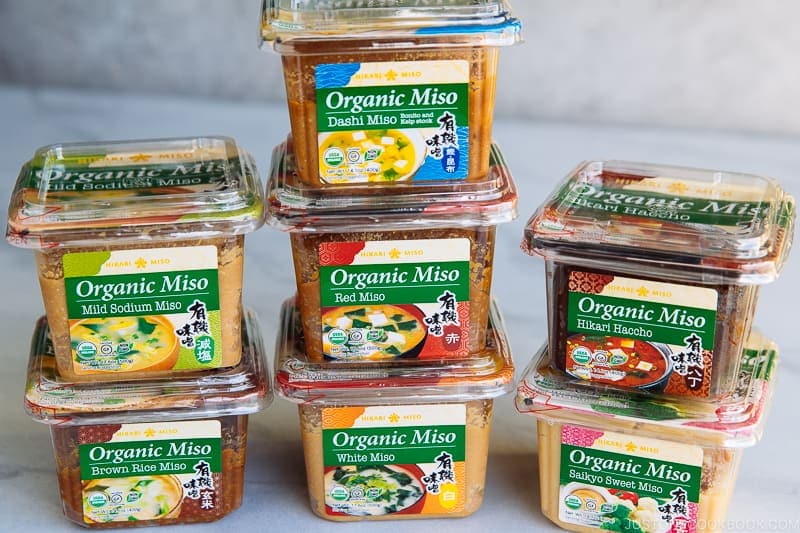
Miso is a Japanese fermented soybean paste, and it’s one of the essential condiments in Japanese cooking. If you are new to miso, I highly recommend taking a look at my Miso pantry page.
Based on the type of miso and the brand that makes it, the flavor of miso varies. In most cases, there is no type or brand that is better or worse, except for your preference. I personally love Hikari Miso® and you will see me using this brand exclusively on my blog.
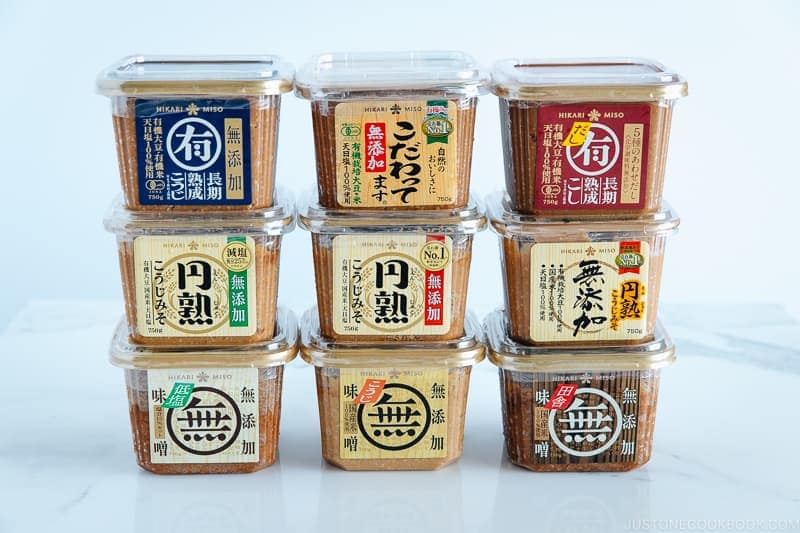
For miso ramen, use any miso type except for hatcho miso or saikyo miso. My favorite miso is kodawattemasu (see below).
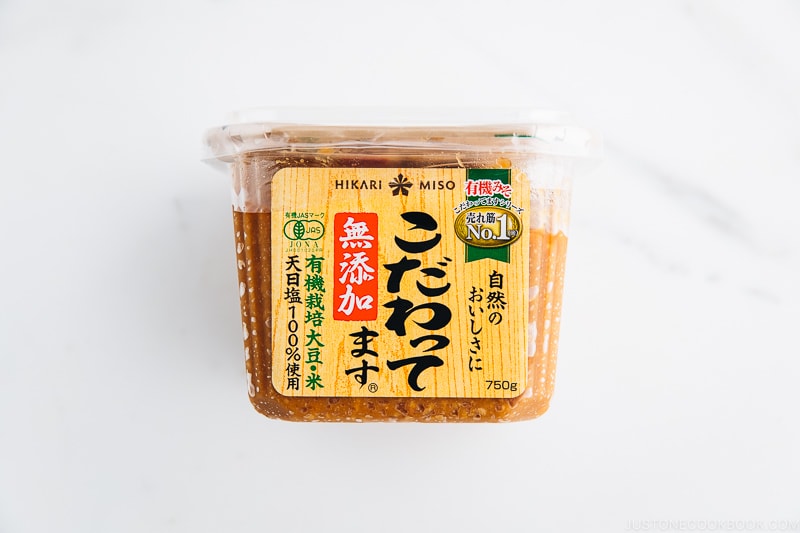
2. Doubanjiang: Spicy or Non-Spicy Bean Paste (Sauce)
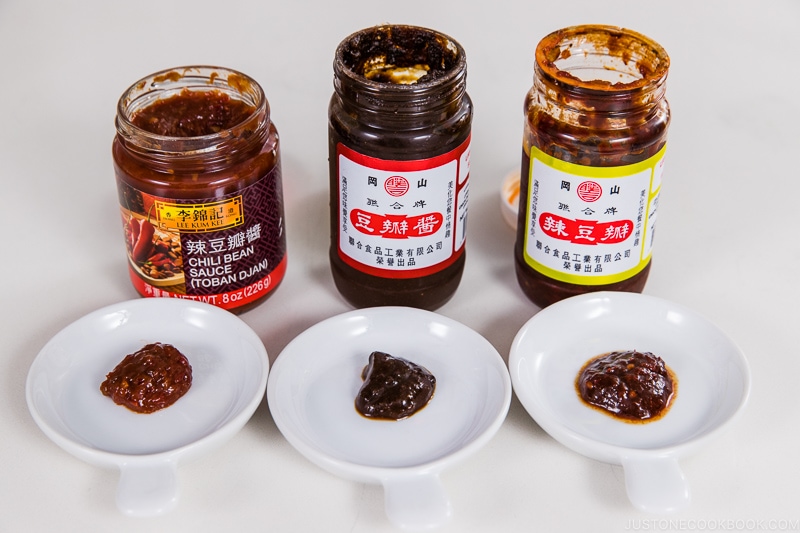
The key condiment in this recipe is doubanjiang (豆板醤) or spicy bean paste, a combination of fermented broad beans as the main ingredient, soybeans, and often hot chilies. The salty, savory, umami-rich paste adds an incredible depth and character to the broth that you should not substitute. You can add more if you like your soup to be spicy, but one teaspoon would be enough to give it a good kick.
Non-Spicy Doubanjiang: Did you know that there is NON-SPICY doubanjiang? Taiwan, Hong Kong, and Guandong in China have non-spicy doubanjiang. It has the same savory depth in the paste, but without the heat.
To distinguish the two versions, the Sichuan doubanjiang is called la-doubanjiang (辣豆瓣醬, “la” (辣) meaning ‘hot’ or ‘spicy’).
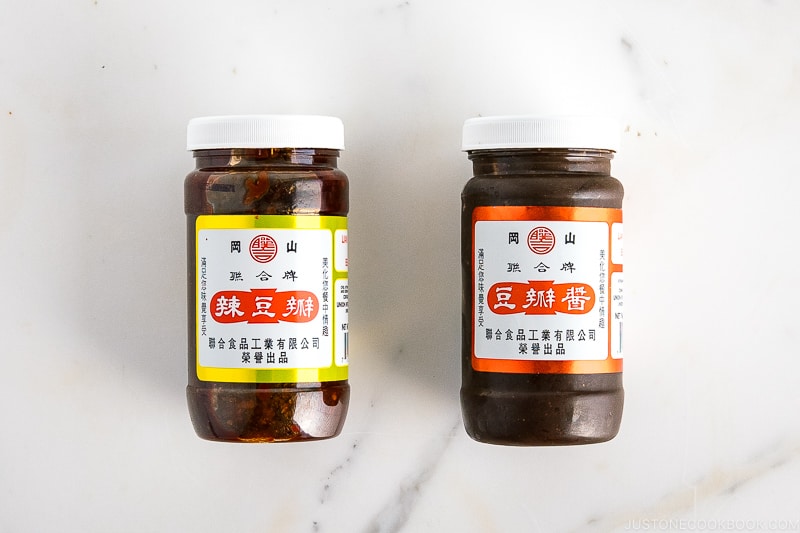
When the kids were small, I use only non-spicy doubanjiang to make my Mapo Tofu and Miso Ramen. Taiwanese brands like Kangshan (岡山) (above) and Ming Teh (明德) offer the doubanjiang made from fermented broad beans and soybeans, and they usually have both spicy and nonspicy versions.
You can get these Taiwanese brands at a local Chinese grocery store. Amazon does not sell the non-spicy doubanjiang at this time (please let me know if you find one).
- Ming Teh Doubanjiang (non-spicy)
- Kangshan Doubanjiang (non-spicy) – Walmart
- Kangshang Doubanjiang (non-spicy) – Weee!
Doubanjiang Substitute: If you really can’t find doubanjiang, you can use gochujang (Korean chili paste; spicy) or doenjang (Korean soybean paste; non-spicy). However, the ingredients are slightly different and have different flavor profiles.
3. Sesame Seeds and Sesame Oil

Sesame flavor in this recipe is prominent as both sesame seeds and oil make the broth nuttier and richer, adding a nice aroma and flavor to the ramen soup.
Japanese households always have a set of suribachi (mortar) and surikogi (pestle) to grind sesame seeds, but if you don’t have one, you can crush the sesame seeds with a food processor (or a coffee bean grinder).
The type of sesame oil you need is dark roasted sesame oil. It has a deep flavor of sesame and only 1 tablespoon would give plenty of fragrance to the soup.
4. Homemade or Store Bought Chicken Broth
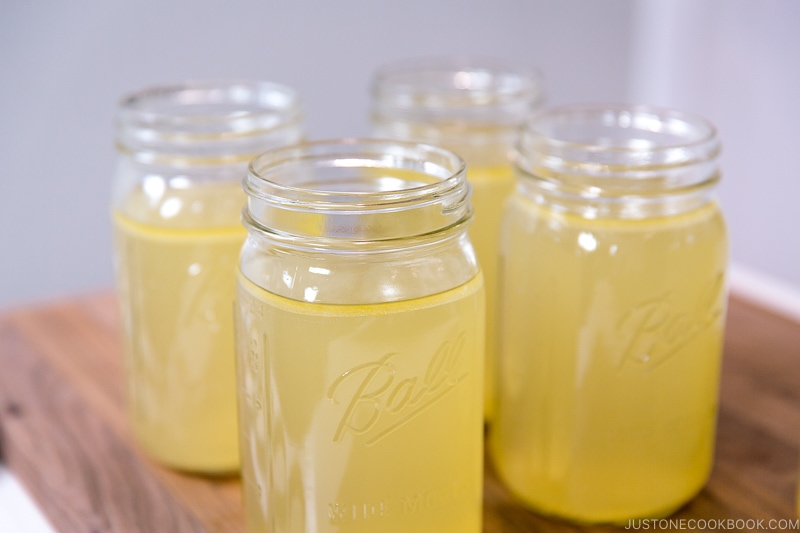
For a richer and more flavorful broth, homemade chicken stock is best. But it’s okay to use store-bought broth to make ramen soup if you don’t have the time.
I like chicken stock from Trader Joe’s. Use less sodium stock and adjust the salt according to your liking. Remember, some chicken stock can be saltier, so you always have to taste your soup before adding salt.
5. White Pepper Powder
I believe white pepper powder is a magical spice in Chinese-style soups and fried rice. Just a few sprinkles of white pepper will elevate the flavor and add a nice kick without the spiciness. You can find white pepper powder in Asian grocery stores or specialty spice shops.
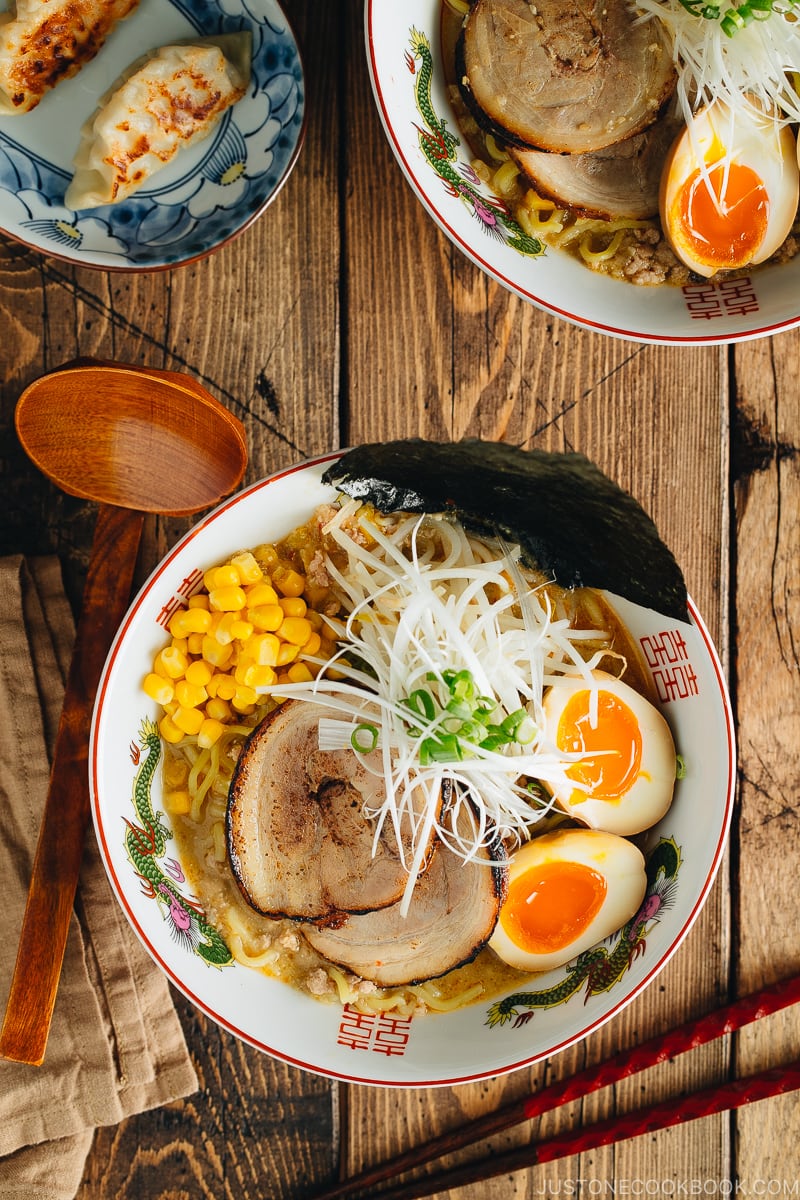
FAQs for Ramen Soup
Do we need to add sugar?
Sugar is not added to sweeten the dish, but it is there to counter the saltiness of miso and doubanjiang (fermented bean paste). Try adding 1 teaspoon at a time and taste the soup before adding more.
Do we need to use sake?
Unless you can’t use it due to religious reasons, I strongly recommend using sake in Japanese cooking. Sake is an essential ingredient such as soy sauce and mirin in Japanese cooking. In this recipe, sake removes the unwanted smell from the meat and adds a subtle sweetness and umami to the soup. The best substitute would be dry sherry and Chinese rice wine.
Part 2: Ramen Noodles 麺
Ramen noodles are made from four basic ingredients: wheat flour, salt, water, and kansui (かん水, saltwater). Kansui is a type of alkaline mineral water, containing sodium carbonate and usually potassium carbonate, and sometimes a small amount of phosphoric acid. Although the color of the ramen noodles is yellowish, they are not egg noodles.
1. Fresh Noodles
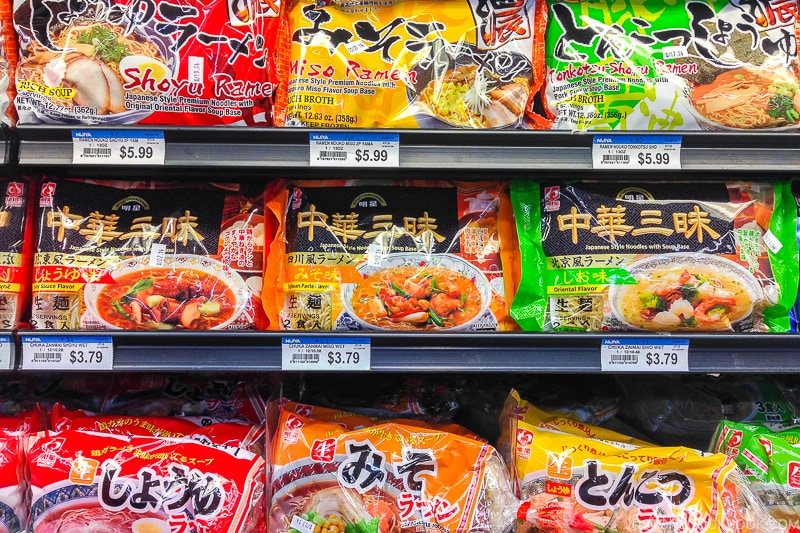
Ideally, fresh ramen noodles are the best. My favorite ramen noodles are from Sun Noodles, and I usually make my own soup instead of the soup base that comes with the package.
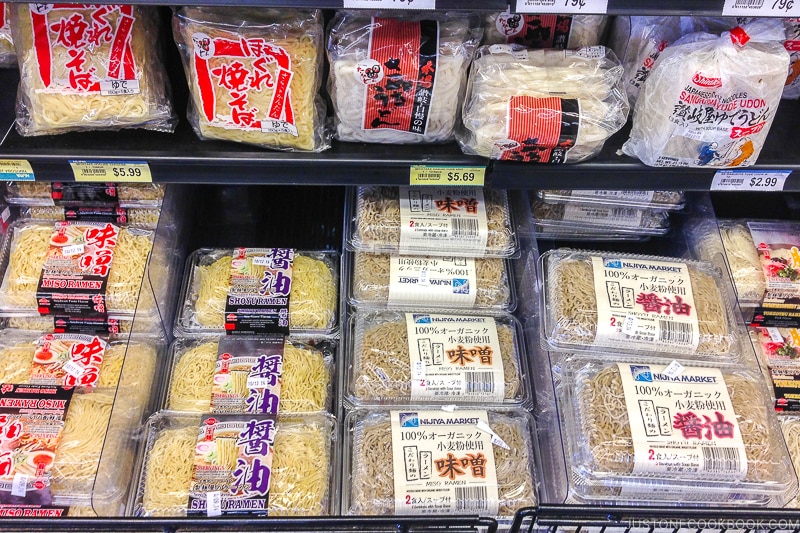
Fresh noodles are available in the refrigerated section of Japanese grocery stores and some Asian grocery stores. Some stores may keep the fresh ramen noodles in the freezer, so don’t forget to check both sections.
Fresh gluten-free ramen noodles can be purchased from Kobayashi Seimen. They are made from rice and taste very similar to fresh ramen noodles.
2. Dried Noodles
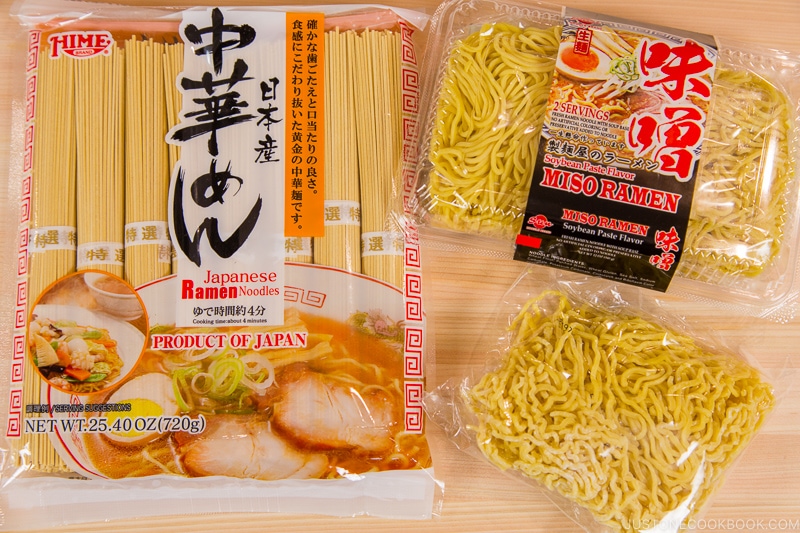
For those who don’t have access to fresh ramen noodles, you can use dried noodles. I’ve tried HIME Japanese ramen noodles (you can purchase them on Amazon) and they are pretty good.
3 Tips for Cooking Ramen Noodles
There are three important tips I want to share with you when cooking ramen noodles.
- Boil the ramen noodles in a big pot of water.
- Do not salt the water like pasta.
- Ramen noodles cook really fast. So make sure to prepare everything ahead of time. Once the noodles are cooked, you have to serve the ramen fast—in less than 30 seconds!
Part 3: Ramen Toppings トッピング
Choices are yours. Here are 7 toppings I added to this Miso Ramen recipe. Even though you would spend less than 30 minutes preparing the ramen on the day of eating, I do spend one day, usually the previous day, preparing my ramen toppings.
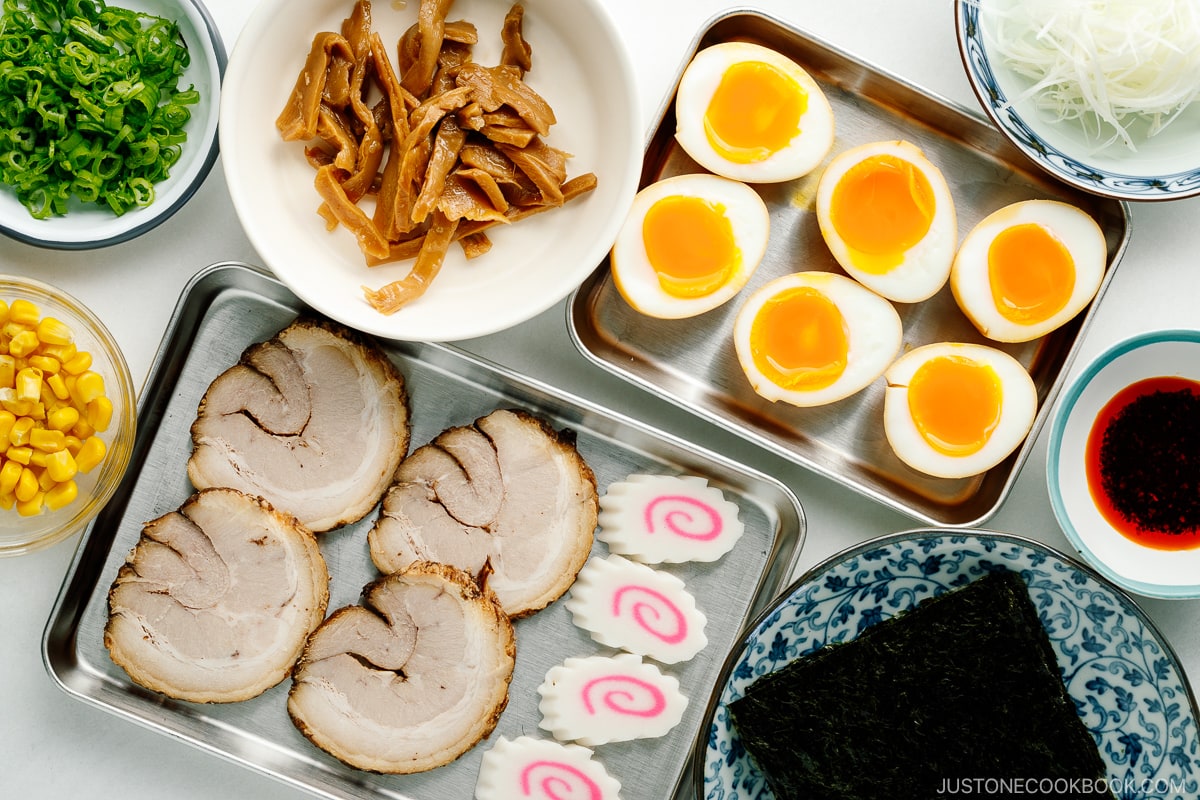
Main Toppings
- Chashu – braised pork belly
- Ramen Egg (Ajitsuke Tamago) – eggs marinated in soy sauce base sauce
- Menma (Seasoned Bamboo Shoots)
- Shiraga Negi – julienned white negi/leeks
- Narutomaki (Japanese fish cakes)
- Sweet corn
- Chopped green onion
- Nori seaweed
Other Topping Ideas:
- Wakame seaweed
- Blanched Bean Sprout (or spicy version)
- Blanched greens (bok choy, spinach, etc.)
- Thinly sliced butter (to make it “miso butter ramen”)
- Or anything you like, tofu, shiitake mushrooms, vegetables such as bean sprouts, garlic chives, etc
Now that you have the template on how to make the best miso ramen at home, it’s time to impress yourself or someone you love with your bowl of ramen goodness. It’s really simple, and dare I say more gratifying than the bowl from your ramen joint!
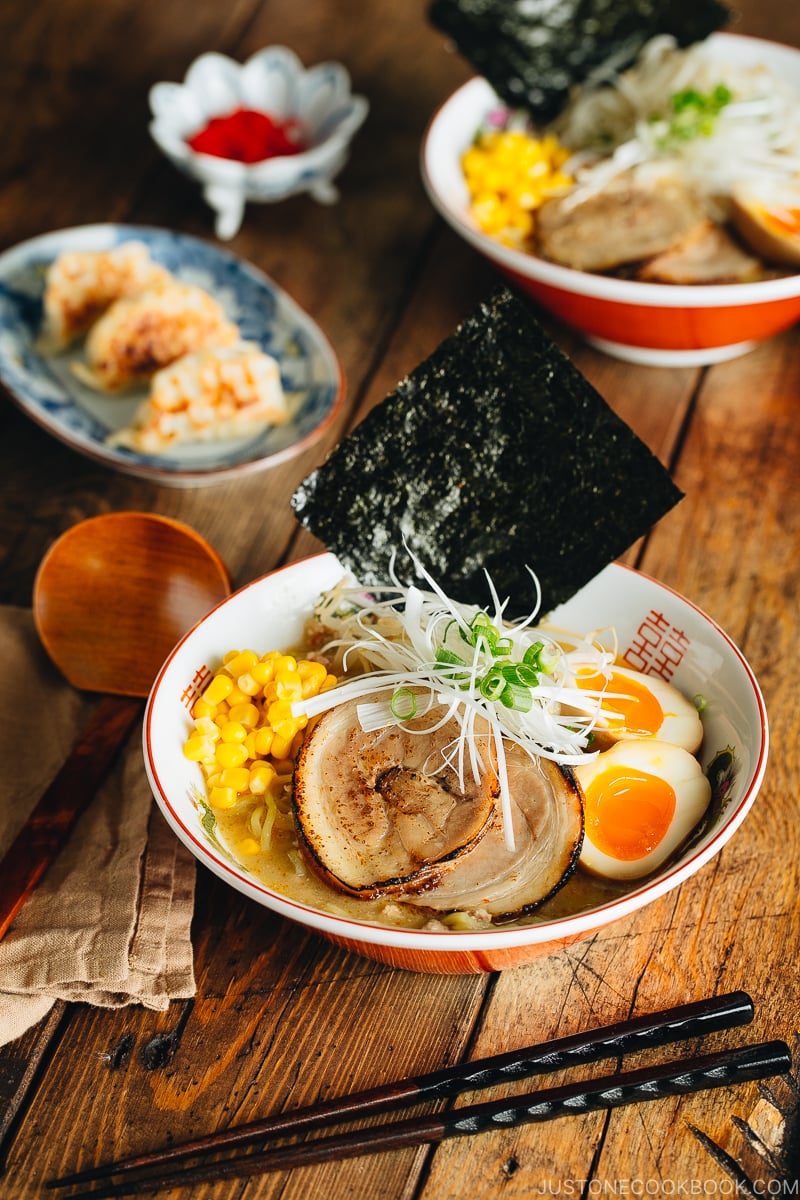
More Ramen Recipes You’ll Love
- Vegetarian Ramen (with an amazingly rich & creamy broth)
- Spicy Shoyu Ramen
- Tsukemen (Dipping Ramen)
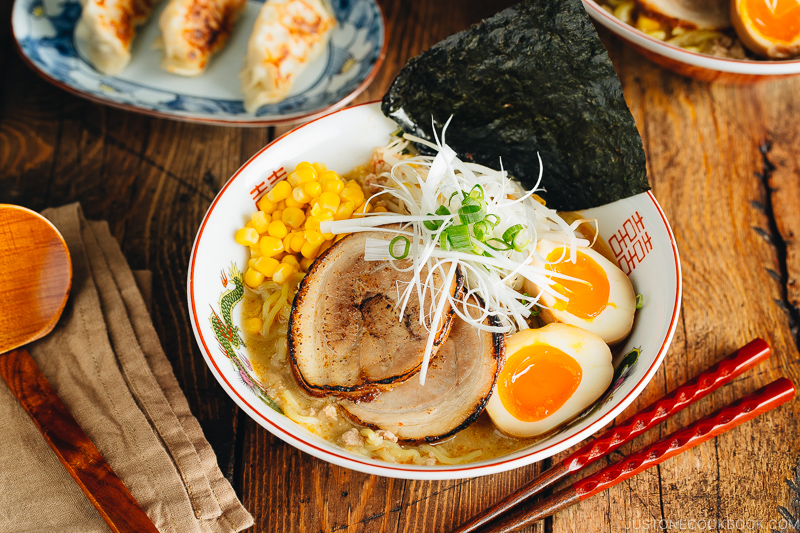
Wish to learn more about Japanese cooking? Sign up for our free newsletter to receive cooking tips & recipe updates! And stay in touch with me on Facebook, Pinterest, YouTube, and Instagram.
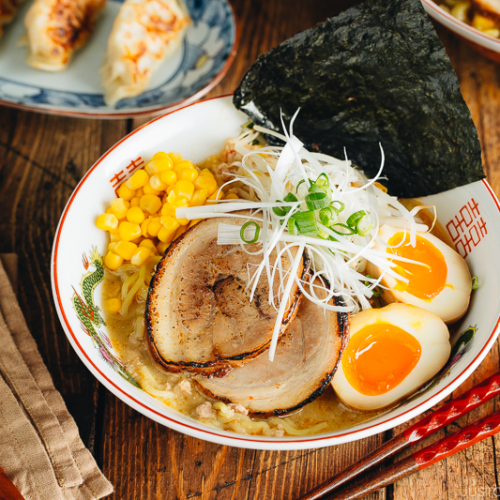
Miso Ramen
Video
Ingredients
For the Soup Broth
- 2 cloves garlic
- ½ tsp ginger (grated)
- 1 shallot
- 1 Tbsp toasted white sesame seeds
- 1 Tbsp toasted sesame oil
- ¼ lb ground pork (use meat alternatives or chopped mushrooms for vegan/vegetarian)
- 1 tsp doubanjiang (spicy chili bean paste) (use the spicy or non-spicy type or gluten-free doubanjiang)
- 3 Tbsp miso (most types will work except Saikyo and Hatcho varieties; each type will create a slightly different broth flavor)
- 1 Tbsp sugar
- 1 Tbsp sake
- 4 cups chicken stock/broth (use vegetable stock for vegan/vegetarian)
- 1 tsp Diamond Crystal kosher salt (to taste)
- ¼ tsp white pepper powder
For the Ramen Noodles
- 2 servings fresh ramen noodles (10–12 oz (283–340 g) fresh noodles or 6.3 oz (180 g) dry ramen noodles; for gluten-free, use GF ramen noodles)
For the Toppings (optional)
- Homemade Chashu (Japanese Braised Pork Belly) (make my Chashu at least a day in advance or buy it premade at a Japanese market; skip for vegan/vegetarian)
- Spicy Bean Sprout Salad (or blanched bean sprouts)
- Ramen Egg (Ajitsuke Tamago) (make my Ramen Eggs at least a day in advance; skip for vegan; slice in half lengthwise to serve)
- frozen or canned corn (drained)
- nori (dried laver seaweed) (cut a sheet into quarters)
- green onion/scallion (chopped)
- Shiraga Negi (julienned long green onions)
For the Condiments (optional)
- la-yu (Japanese chili oil) (make my Homemade La-yu)
- pickled red ginger (beni shoga or kizami beni shoga)
- white pepper powder
Instructions
Before You Start…
- Prepare the ramen toppings ahead of time—a day in advance for the Homemade Chashu (Japanese Braised Pork Belly) and Ramen Egg (Ajitsuke Tamago)—so they‘re ready to serve with your piping-hot bowl of ramen.

- For toppings, I add chashu, ramen egg, blanched bean sprouts (or Spicy Bean Sprout Salad), frozen or canned corn, Shiraga Negi (julienned long green onions), chopped green onion/scallion, and a sheet of nori (dried laver seaweed). You can find their recipes in the hyperlinks. For the optional condiments, prepare a bottle of la-yu (Japanese chili oil), pickled red ginger (beni shoga or kizami beni shoga), and some white pepper powder on the table.
To Prepare the Ingredients
- Gather all the ingredients.

- Mince or press 2 cloves garlic (I use a garlic press) and add to a small plate. Then, grate the ginger (I use a ceramic grater) and add ½ tsp ginger (grated) to the plate.

- Mince 1 shallot and add to the plate and set these three prepared ingredients aside.

- Grind 1 Tbsp toasted white sesame seeds, leaving some seeds unground for texture. Set aside.

To Make the Soup Broth
- Preheat a medium pot over medium-low heat. When it‘s hot, add 1 Tbsp toasted sesame oil. Then, add the garlic, ginger, and shallot.

- With a wooden spatula, stir-fry until fragrant.

- Add ¼ lb ground pork and increase the heat to medium. Cook the meat until it‘s no longer pink.

- Add 1 tsp doubanjiang (spicy chili bean paste) and 3 Tbsp miso. Quickly blend well with the meat before they get burnt.

- Add the ground sesame seeds and 1 Tbsp sugar and mix well.

- Add 1 Tbsp sake and 4 cups chicken stock/broth and bring the mixture to a simmer.

- Taste your soup and add up to 1 tsp Diamond Crystal kosher salt (if necessary) and ¼ tsp white pepper powder. Tip: Each brand of chicken stock varies in saltiness, so you must taste your soup to decide how much salt to add.

- Your soup broth is now done. Cover with the lid and keep the soup broth simmering while you cook the noodles.

To Prepare the Ramen Noodles
- Bring a large pot of unsalted water to a boil (ramen noodles already include salt in the dough). When the water is boiling, ladle some of the hot water into the individual ramen bowls to warm them up. Meanwhile, gently shake 2 servings fresh ramen noodles with your hand to separate and loosen them up.

- Cook the noodles according to the package instructions. I usually cook the noodles al dente (about 15 seconds less than the suggested cooking time). Before your noodles are done cooking, empty the hot water from the warmed ramen bowls.

- When the noodles are done, quickly pick them up with a mesh sieve and shake out the excess water. Make sure to drain the water well, as you don’t want it to dilute your soup. Serve the noodles into the warmed bowls.

To Serve
- Add the piping-hot ramen soup broth to each bowl.

- Place the toppings of your choice on the ramen noodles and serve immediately. Add the optional condiments to your Miso Ramen and enjoy.

To Store
- You can keep the soup broth in the refrigerator for 3 days. Cook the noodles right before serving.
Nutrition
Editor’s Note: This post was originally published in May 2011. New video and photos are added in September 2014. The video and images have been updated in May 2019. The post has been republished in February 2022.
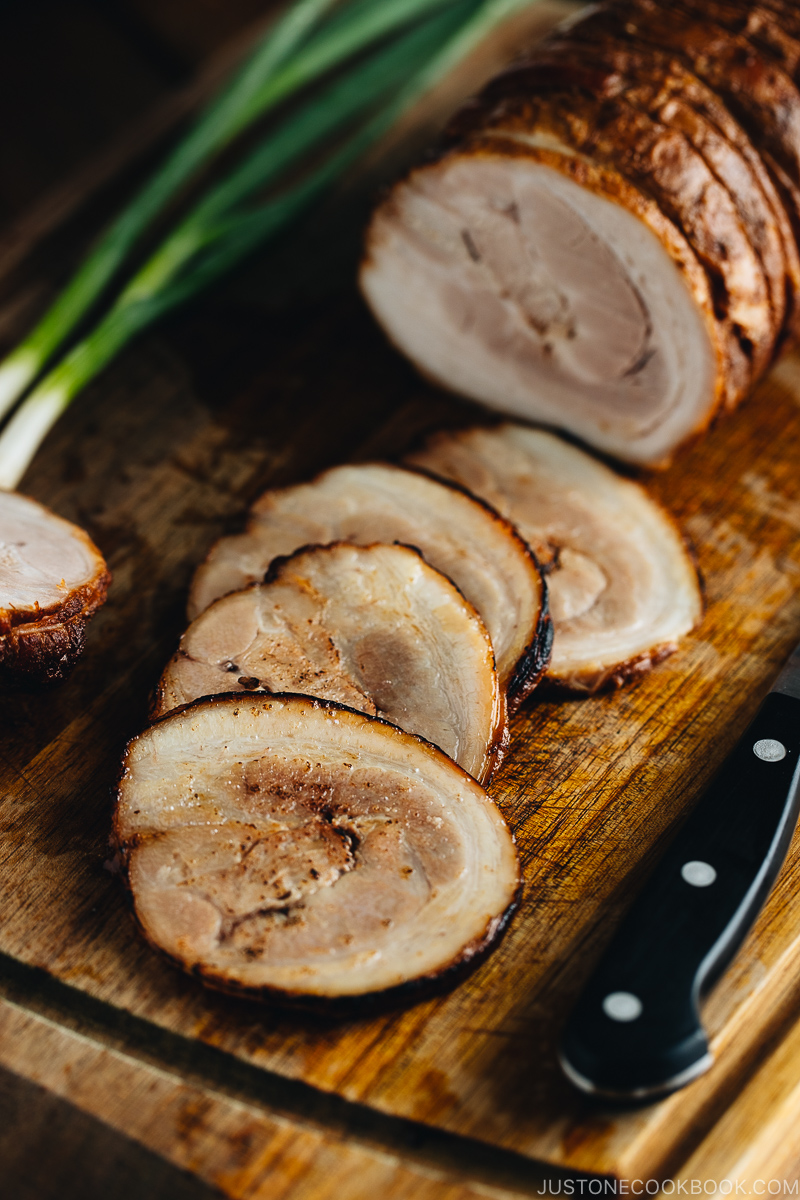
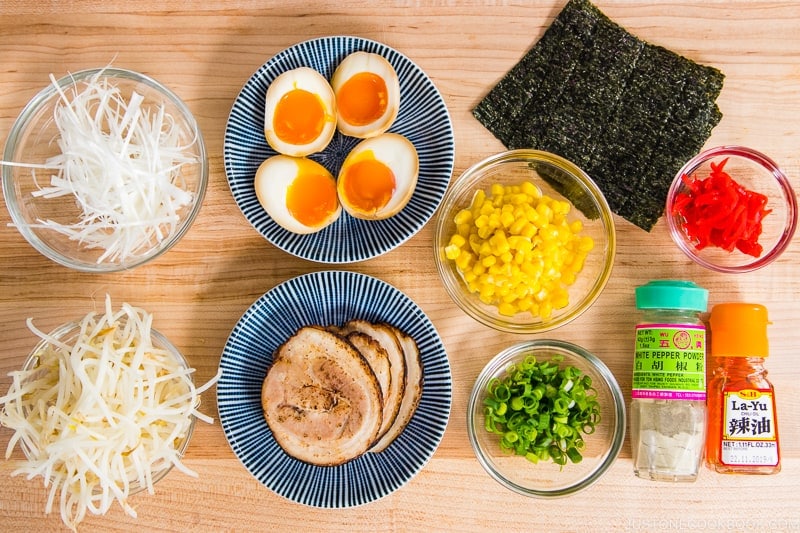
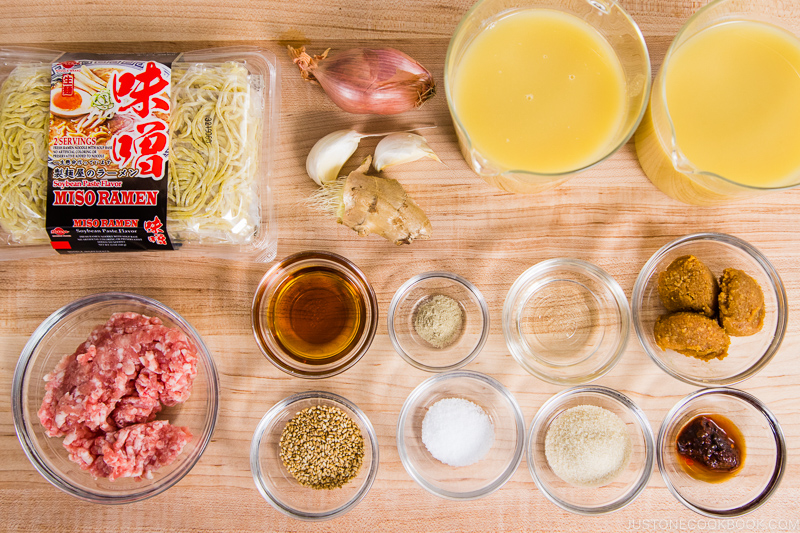
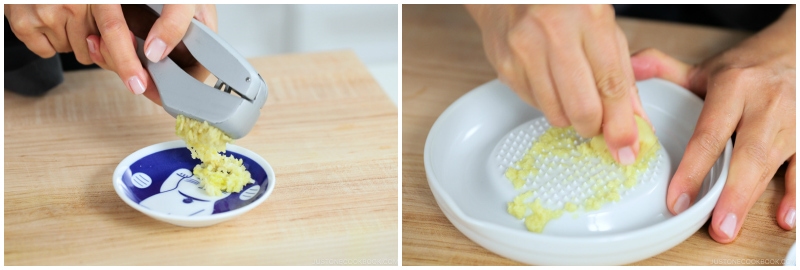

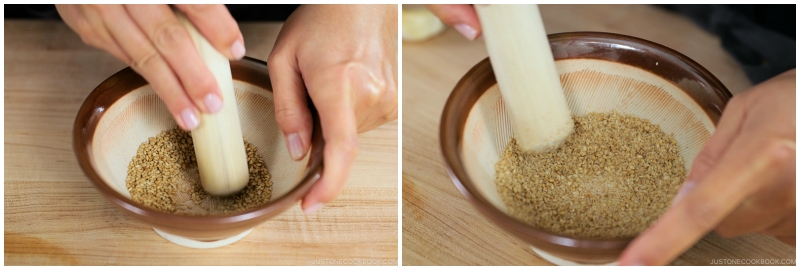
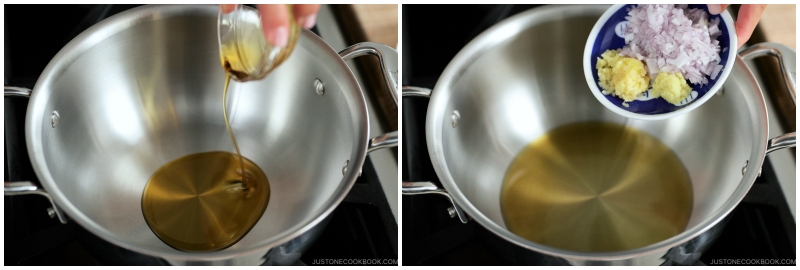
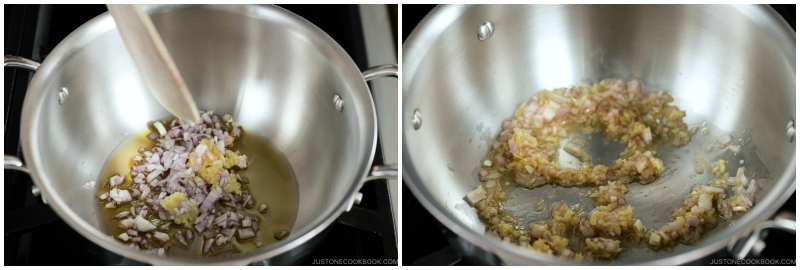
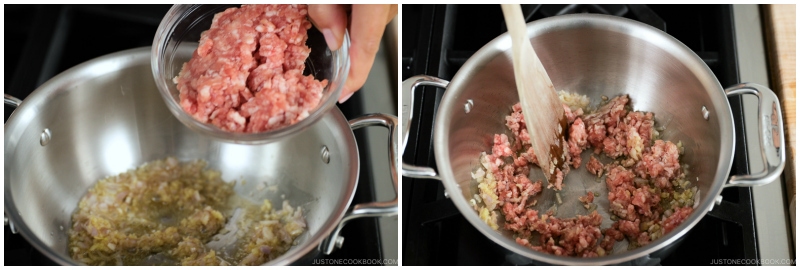
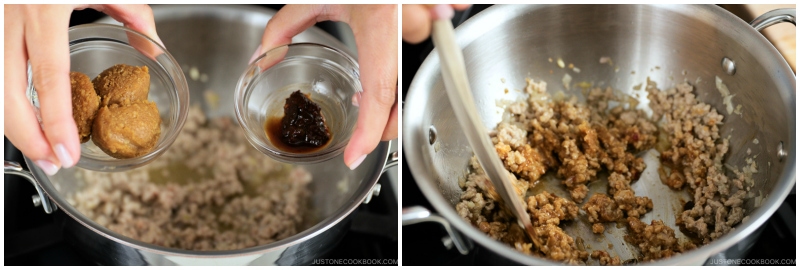
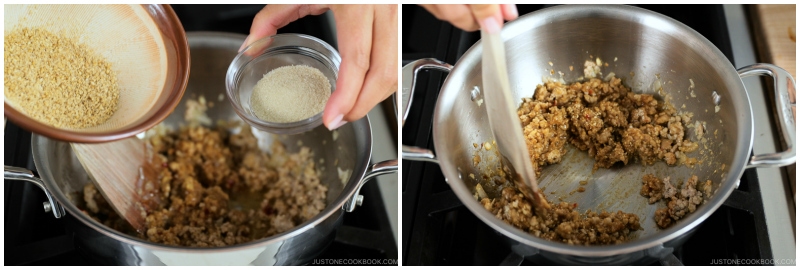
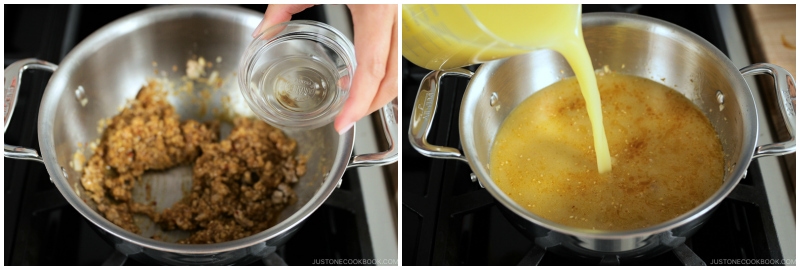
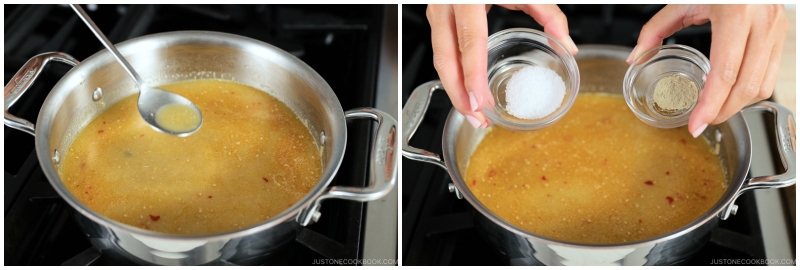
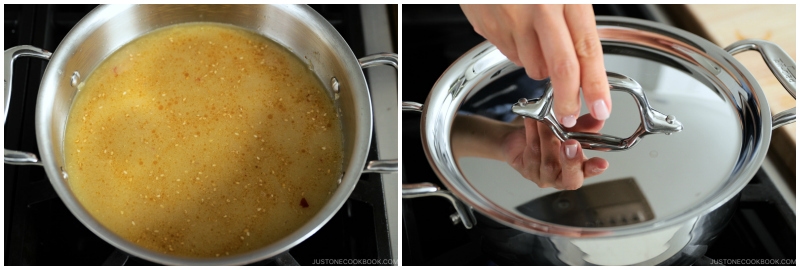
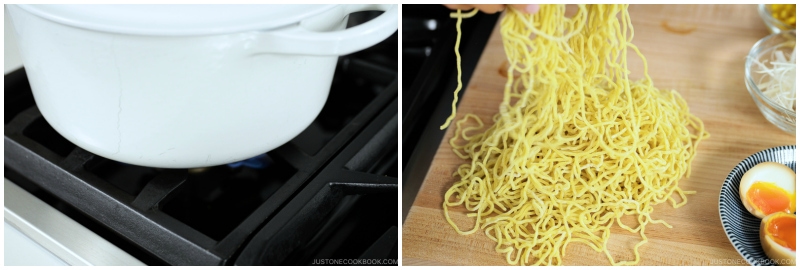
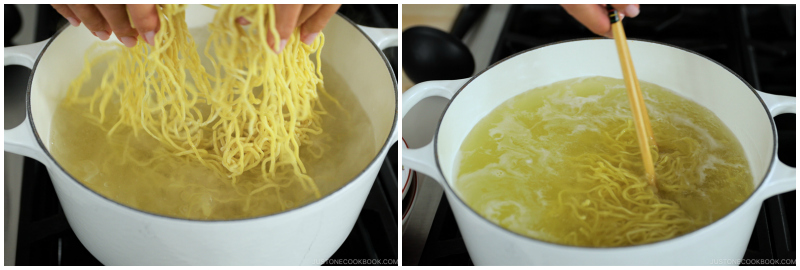
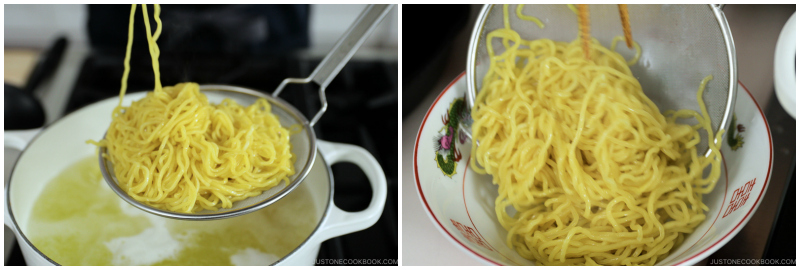
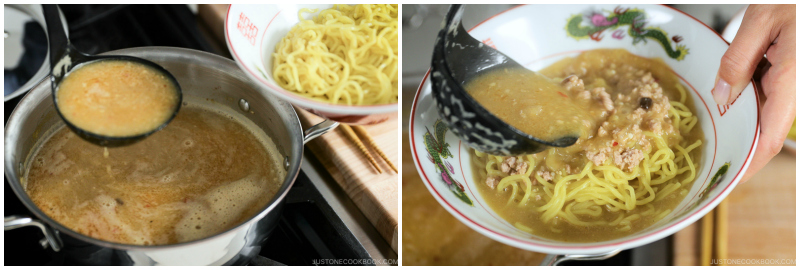
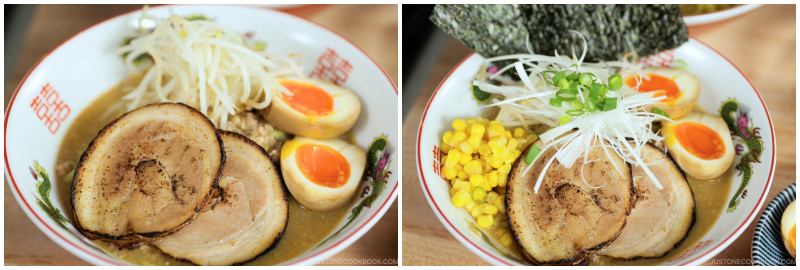











These are delicious! Any chance for Shio or Tonkotsu ramen recipe? While my husband and I prefer miso ramen, our boys prefer the shio or tonkotsu over miso. Thank you 🙏
its the same recipe just swap the miso.
Hi Momo! Thank you very much for trying Nami’s recipe and for your kind feedback!
To make Tonkotsu or Shiro Ramen, it needs a good broth flavor which requires a long process. The broth has to be simmer pork born for hours with aromatics to extract the collagen from the bones.
Currently, we only have a quick ramen recipe that can be easily made at home. Sorry!
I made this last night and just want to say thank you and how absolutely delicious this was. Because of our dietary needs I had to make a couple of changes: I substituted ground chicken ( because my husband doesn’t eat pork) and I used a splash of rice cooking wine instead of sake because I didn’t have it. And honestly, it was better than I could’ve ever even hoped for. My add-ons were Chashu chicken, Ajitama (seasoned eggs), shelled edamame, zucchini noodles, bean sprouts, sliced green onions and gluten-free rice ramen. My only wish is that there was more of the broth because it was so beautifully delicate and flavorful. I was actually surprised at how wonderfully complex it was. I can’t wait to make this again. I even bought beautiful bowls for it for next time. So thank you, thank you, thank you for this absolute treasure of a recipe.
Hi Marlene! Thank you very much for your kind feedback!
Nami and JOC team are so happy to hear this recipe worked out very well for you.🥰 Thank you for trying this recipe!
Nami-san
Do you have a suggestion for making a very large batch of the soup? It would be for a large party, 25+ people.
Our family loves this recipe!
Hi モーリーの召使い! Thank you very much for trying Nami’s recipe! Nami and JOC team are so happy to hear your family loves this recipe!
We have not made 25+ Ramen at once before, but we think the broth amount will be too much if you simply change the servings number on the recipe card. The recipe includes the extra liquid for evaporation, so it needs a bit of adjustment.
For example, Each bowl needs about 1.5 cups.(1.5 x 25 = 37.5 cups total for your servings) Let’s say 1 cup for the evaporation. Then you only need about 38.5 cups of Chicken stock.
Another tip is not to cook all the ramen noodles at once unless you have a huge pot for boiling the 25 noodles together.😉
We hope this helps!
こんにちは!
it worked out so good! Everyone has asked for the recipe!! I still make smaller size (double) often for my family. 😉
Hi モーリーの召使い-san! Aww. We are so happy to hear this worked out well for you!❤️
Thank you very much for your update and kind feedback. Happy Cooking!
Can I substitute the pork ingredients with ones made from chicken or beef? I’m from Israel, so pork is very hard to come by here since it’s not kosher
Hi Dan! Thank you very much for trying Nami’s recipe!
If that is the case, the flavor will be different, but you can use other proteins/meat.
We hope this helps!
Love this recipe. I’ve made it several times now. This time I made my own broth using pork bones and it was wonderful!
Hi Felicia! Wow!🤩 With homemade pork bone broth! It must be yummy!
Thank you very much for trying Nami’s recipe and for your kind feedback!
美味しい!I’m Chinese but I was born and raised in Los Angeles. I grew up eating California Rolls and later learned to love most Japanese food, including sashimi. Anyway, I made this recipe a couple of times already. It tastes like restaurant quality. Left the sake out but it was still good. Thanks for sharing!
Hi Esther! Thank you very much for trying this recipe and for your kind feedback!
We are so happy to hear you enjoyed homemade Miso ramen!🥰
Hi! Do you think I could substitute chicken broth for dashi instead? Recipe looks great, can’t wait to try it out <3
Hi Ellie, The chicken stock is more flavorful than Japanese dashi-based broth, and adding meat (and sesame seeds) adds extra complexity to the sauce. If you use dashi, we recommend adjusting the whole seasonings to have a good balance. Nami has a vegetarian ramen recipe that uses dashi as a base, and we recommend it as well.
https://www.justonecookbook.com/vegetarian-ramen/
We hope this helps!
Thanks for the Ramen post. I’ve been experimenting with making ramen for a few years, and while getting better at it, I enjoy learning more.
One trick I learned towards making broth, is to buy bone-in and skin-on chicken thighs. That way I can freeze and save the bones for making broth later on. Same thing for when buying pork. Roasting the bones a little first helps the flavor. Adding vinegar to the stock water also helps extract more flavor, too, prior to the initial boil and simmering of the bones.
When done, let cool and freeze for when you’re ready to make ramen.
Hi David! Awesome!🤩
Thank you very much for reading Nami’s post and sharing your experience and tips with us!
I love your blog and had been trying your recipes! They are wonderful and you explain ingredients and steps very well, in great details.
I have a pasta maker and would like to make my own ramen noodles. Have you ever tried? Please share your recipe and experience. Thank you and keep up the good work!
Hi Rossana! Thank you very much for trying many of Nami’s recipes and for your kind feedback!
We are so happy to hear you enjoy Nami’s blog and recipes!
We currently don’t have the homemade ramen noodle recipe on the site. We’ll make sure to add the recipe to Nami’s list. Thanks for your request!
This was absolutely amazing! I could only find the dark miso in The Netherlands but it tasted delicious! Thank you so much for this recipe!
Hi Anne, Thank you very much for trying Nami’srecipe!
We are so glad to hear it come out delicious! Happy Cooking!
OMG, where did you get those bowls?? I have the same bowls which my mom gave me, but she got them over 40 years ago. I was looking for more to add to the set, literally yesterday on ebay before seeing this post.
Nevermind, it occurred to me that someone else might have asked in the comments and I see that you had already answered…thank you!!
https://mtckitchen.com/tableware/ramen-essentials/ramen-bowls/
Hi DelMar! Perfect! We are glad to hear you found them! 🙂
Thank you for reading Nami’s post!
Hi Nami, this is a versatile recipe, I’ve made it many times in the kitchen and known to my kids as “Mama’s noodle soup”. Really glad i found this recipe. Thanks so much for sharing, your website is my regular go-to-site for my family meal planning !
Hi Lia! Thank you very much for trying this recipe and for your kind feedback!
Nami and JOC team are so glad to hear you and your family enjoy this recipe and many others!🥰
Have to order more La Doubanjiang. I really want to make this.
Hi Barbara, Thank you very much for reading Nami’s post! We hope you enjoy this recipe!
Hi Nami! Im excited to try out this recipe, but beforehand may i ask, do you think the taste will be just as delicious if i substitute the ramen with soba noodle?
Hi Athirah, Thank you very much for reading Nami’s post!
The soba noodle (made from buckwheat) has a bitter taste, and the texture is different. However, we think it up to your preference, and you might like it.😉
Hi Nami!
We have tried this recipe and we loved it so much <3
However this time we would need to prepare some steps in advance. We can't decide which is the right moment to "stop" the recipe. Should we prepare all the ramen (without the noodles and toppings) and keep it in the fridge for a couple of days? Does it tastes any better if it's prepare in advance?
Or should we just mix all the ingredients at the last moment?
How long it last once prepared? Thanks a lot 🙂
Hi Mar, Thank you very much for trying Nami’s recipe and for your kind feedback!
You can store the broth for up to 3~4 days in the refrigerator.
How about preparing the broth and some topping like ramen eggs in advance? Nami usually prepares this ramen broth on the day.